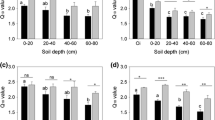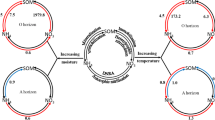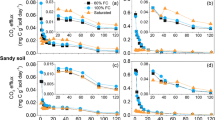Abstract
Purpose
The purpose of this study was to investigate how changes in substrate availability (stimulating root exudate input) affect the temperature response (Q10) of soil organic carbon (SOC) mineralization across different soil profiles to increase our ability to predict the response of soil organic matter dynamics to climate change.
Materials and methods
We sampled the topsoil and subsoil of two typical mineral soil profiles and one buried soil profile. Soils were incubated at 10–25 °C at 0.75 °C intervals, SOC mineralization rates were continuously measured with and without glucose addition, and Q10 was calculated.
Results and discussion
Our results showed that Q10 decreased with increasing depth in typical mineral soils, but decreased before increasing with depth in buried soil. As expected, substrate addition significantly increased Q10 across soil depths; however, the magnitude of this increase (ΔQ10) differed with soil depth and type. Unexpectedly, in typical mineral soils, ΔQ10 was higher in topsoil than in subsoils, and vice versa for buried soil. ΔQ10 was negatively correlated with initial soil substrate availability (CAI) and positively correlated with soil inorganic N.
Conclusions
Overall, our results suggested that increased substrate availability under climate change scenarios (i.e., increased root exudates with elevated CO2 concentrations) could further strengthen the temperature response of SOC mineralization, especially in soils with high inorganic N content or regions with high N deposition rates.





Similar content being viewed by others
Data availability
All data generated or analyzed during this study are included in this article.
References
Batjes NH (1996) Total carbon and nitrogen in the soils of the world. Eur J Soil Sci 47:151–163
Bond-Lamberty B, Thomson A (2010) Temperature-associated increases in the global soil respiration record. Nature 464:579–582
Bosatta E, Agren GI (1999) Soil organic matter quality interpreted thermodynamically. Soil Biol Biochem 31:1889–1891
Bradford MA, Wieder WR, Bonan GB, Fierer N, Raymond PA, Crowther TW (2016) Managing uncertainty in soil carbon feedbacks to climate change. Nat Clim Chang 6:751–758
Canarini A, Kaiser C, Merchant A, Richter A, Wanek W (2019) Root exudation of primary metabolites: Mechanisms and their roles in plant responses to environmental stimuli. Front Plant Sci 10:1–19
Chang J, Zhu J, Xu L, Su H, Gao Y, Cai X, Peng T, Wen X, Zhang J, He N (2018) Rational land-use types in the karst regions of China: Insights from soil organic matter composition and stability. CATENA 160:345–353
Cheng W, Zhang Q, Coleman DC (1996) Is available carbon limiting microbial respiration in the rhizosphere? Soil Biol Biochem 28:1283–1288
Conant RT, Ryan MG, Ågren GI, Birge HE, Davidson EA, Eliasson PE, Evans SE, Frey SD, Giardina CP, Hopkins FM, Hyvönen R, Kirschbaum MUF, Lavallee JM, Leifeld J, Parton WJ, Megan Steinweg J, Wallenstein MD, Martin Wetterstedt JÅ, Bradford MA (2011) Temperature and soil organic matter decomposition rates - synthesis of current knowledge and a way forward. Glob Change Biol 17:3392–3404
Crowther TW, Todd-Brown KEO, Rowe CW, Wieder WR, Carey JC, MacHmuller MB, Snoek BL, Fang S, Zhou G, Allison SD, Blair JM, Bridgham SD, Burton AJ, Carrillo Y, Reich PB, Clark JS, Classen AT, Dijkstra FA, Elberling B, Emmett BA, Estiarte M, Frey SD, Guo J, Harte J, Jiang L, Johnson BR, Kroël-Dulay G, Larsen KS, Laudon H, Lavallee JM, Luo Y, Lupascu M, Ma LN, Marhan S, Michelsen A, Mohan J, Niu S, Pendall E, Peñuelas J, Pfeifer-Meister L, Poll C, Reinsch S, Reynolds LL, Schmidt IK, Sistla S, Sokol NW, Templer PH, Treseder KK, Welker JM, Bradford MA (2016) Quantifying global soil carbon losses in response to warming. Nature 540:104–108
Davidson EA, Janssens IA (2006) Temperature sensitivity of soil carbon decomposition and feedbacks to climate change. Nature 440:165–173
Davidson EA, Janssens IA, Luo Y (2006) On the variability of respiration in terrestrial ecosystems: moving beyond Q10. Glob Change Biol 12:154–164
Doetterl S, Stevens A, Six J, Merckx R, Van Oost K, Casanova Pinto M, Casanova-Katny A, Muñoz C, Boudin M, Zagal Venegas E, Boeckx P (2015) Soil carbon storage controlled by interactions between geochemistry and climate. Nat Geosci 8:780–783
Dungait JAJ, Hopkins DW, Gregory AS, Whitmore AP (2012) Soil organic matter turnover is governed by accessibility not recalcitrance. Glob Change Biol 18:1781–1796
Erhagen B, Ilstedt U, Nilsson MB (2015) Temperature sensitivity of heterotrophic soil CO2 production increases with increasing carbon substrate uptake rate. Soil Biol Biochem 80:45–52
Fang C, Smith P, Moncrieff JB, Smith JU (2005) Erratum: Similar response of labile and resistant soil organic matter pools to changes in temperature. Nature 436:57–59
Fierer N, Allen AS, Schimel JP, Holden PA (2003) Controls on microbial CO2 production: A comparison of surface and subsurface soil horizons. Glob Change Biol 9:1322–1332
Frey SD, Lee J, Melillo JM, Six J (2013) The temperature response of soil microbial efficiency and its feedback to climate. Nat Clim Chang 3:395–398
Gentsch N, Wild B, Mikutta R, Čapek P, Diáková K, Schrumpf M, Turner S, Minnich C, Schaarschmidt F, Shibistova O, Schnecker J, Urich T, Gittel A, Šantrůčková H, Bárta J, Lashchinskiy N, Fuß R, Richter A, Guggenberger G (2018) Temperature response of permafrost soil carbon is attenuated by mineral protection. Glob Change Biol 24:3401–3415
Gershenson A, Bader NE, Cheng W (2009) Effects of substrate availability on the temperature sensitivity of soil organic matter decomposition. Glob Change Biol 15:176–183
Gillabel J, Cebrian-Lopez B, Six J, Merckx R (2010) Experimental evidence for the attenuating effect of SOM protection on temperature sensitivity of SOM decomposition. Glob Change Biol 16:2789–2798
Gross CD, Harrison RB (2019) The case for digging deeper: Soil organic carbon storage, dynamics, and controls in our changing world. Soil Systems 3:1–24
Hamdi S, Moyano F, Sall S, Bernoux M, Chevallier T (2013) Synthesis analysis of the temperature sensitivity of soil respiration from laboratory studies in relation to incubation methods and soil conditions. Soil Biol Biochem 58:115–126
He N, Yu G (2016) Stoichiometrical regulation of soil organic matter decomposition and its temperature sensitivity. Ecol Evol 6:620–627. https://doi.org/10.1002/ece3.1927
Hicks Pries CE, Castanha C, Porras R, Phillips C, Torn MS (2017) The whole-soil carbon flux in response to warming. Science 355:1420–1423
Jenkinson DS, Brookes PC, Powlson DS (2004) Measuring soil microbial biomass. Soil Biol Biochem 36:5–7
Jian J, Steele MK, Thomas RQ, Day SD, Hodges SC (2018) Constraining estimates of global soil respiration by quantifying sources of variability. Glob Change Biol 24:4143–4159
Karhu K, Fritze H, Tuomi M, Vanhala P, Spetz P, Kitunen V, Liski J (2010) Temperature sensitivity of organic matter decomposition in two boreal forest soil profiles. Soil Biol Biochem 42:72–82
Keiluweit M, Bougoure JJ, Nico PS, Pett-Ridge J, Weber PK, Kleber M (2015) Mineral protection of soil carbon counteracted by root exudates. Nat Clim Chang 5:588–595
Kuzyakov Y (2010) Priming effects: interactions between living and dead organic matter. Soil Biology and Biochemistry 42:1363–1371
Larionova AA, Yevdokimov IV, Bykhovets SS (2007) Temperature response of soil respiration is dependent on concentration of readily decomposable C. Biogeosciences 4:1073–1081
Lehmann J, Kleber M (2015) The contentious nature of soil organic matter. Nature 528:60–68
Li J, Pei J, Pendall E, Reich PB, Noh NJ, Li B, Fang C, Nie M (2020) Rising temperature may trigger deep soil carbon loss across forest ecosystems. Advanced Science 7:1–8
Liu Y, He N, Wen X, Xu L, Sun X, Yu G, Liang LL, Schipper LA (2018) The optimum temperature of soil microbial respiration: Patterns and controls. Soil Biol Biochem 121:35–42
Liu Y, He N, Xu L, Tian J, Gao Y, Zheng S, Wang Q, Wen X, Xu X, Yakov K (2019) A new incubation and measurement approach to estimate the temperature response of soil organic matter decomposition. Soil Biol Biochem 138:107596
Liu Y, He N, Zhu J, Xu L, Yu G, Niu S, Sun X, Wen X (2017) Regional variation in the temperature sensitivity of soil organic matter decomposition in China’s forests and grasslands. Glob Change Biol 23:3393–3402
Liu Y, Xu L, Zheng S, Chen Z, Cao Y, Wen X, He N (2021) Temperature sensitivity of soil microbial respiration in soils with lower substrate availability is enhanced more by labile carbon input. Soil Biol Biochem 154:108148
Moinet GYK, Hunt JE, Kirschbaum MUF, Morcom CP, Midwood AJ, Millard P (2018) The temperature sensitivity of soil organic matter decomposition is constrained by microbial access to substrates. Soil Biol Biochem 116:333–339
Mu C, Zhang T, Zhang X, Cao B, Peng X (2016) Sensitivity of soil organic matter decomposition to temperature at different depths in permafrost regions on the northern Qinghai-Tibet Plateau. Eur J Soil Sci 67:773–781
Norby RJ, Ledford J, Reilly CD, Miller NE, O’Neill EG (2004) Fine-root production dominates response of a deciduous forest to atmospheric CO2 enrichment. Proc Natl Acad Sci USA 101:9689–9693
Nottingham AT, Meir P, Velasquez E, Turner BL (2020) Soil carbon loss by experimental warming in a tropical forest. Nature 584:234–237
Pang X, Zhu B, Lü X, Cheng W (2015) Labile substrate availability controls temperature sensitivity of organic carbon decomposition at different soil depths. Biogeochemistry 126:85–98
Phillips RP, Finzi AC, Bernhardt ES (2011) Enhanced root exudation induces microbial feedbacks to N cycling in a pine forest under long-term CO2 fumigation. Ecol Lett 14:187–194
Preusser S, Poll C, Marhan S, Angst G, Mueller CW, Bachmann J, Kandeler E (2019) Fungi and bacteria respond differently to changing environmental conditions within a soil profile. Soil Biol Biochem 137:107543
Qin S, Chen L, Fang K, Zhang Q, Wang J, Liu F, Yu J, Yang Y (2019) Temperature sensitivity of SOM decomposition governed by aggregate protection and microbial communities. Sci Adv 5:1–10
Robinson JM, O’Neill TA, Ryburn J, Liang LL, Arcus VL, Schipper LA (2017) Rapid laboratory measurement of the temperature dependence of soil respiration and application to changes in three diverse soils through the year. Biogeochemistry 133:101–112
Schindlbacher A, Rodler A, Kuffner M, Kitzler B, Sessitsch A, Zechmeister-Boltenstern S (2011) Experimental warming effects on the microbial community of a temperate mountain forest soil. Soil Biol Biochem 43:1417–1425
Schmidt MWI, Torn MS, Abiven S, Dittmar T, Guggenberger G, Janssens IA, Kleber M, Kögel-Knabner I, Lehmann J, Manning DAC, Nannipieri P, Rasse DP, Weiner S, Trumbore SE (2011) Persistence of soil organic matter as an ecosystem property. Nature 478:49–56
Shahzad T, Rashid MI, Maire V, Barot S, Perveen N, Alvarez G, Mougin C, Fontaine S (2018) Root penetration in deep soil layers stimulates mineralization of millennia-old organic carbon. Soil Biol Biochem 124:150–160
Six J, Bossuyt H, Degryze S, Denef K (2004) A history of research on the link between (micro)aggregates, soil biota, and soil organic matter dynamics. Soil and Tillage Research 79:7–31
Soong JL, Castanha C, Hicks Pries CE, Ofiti N, Porras RC, Riley WJ, Schmidt MWI, Torn MS (2021) Five years of whole-soil warming led to loss of subsoil carbon stocks and increased CO2 efflux. Sci Adv 7:1–9
Soong JL, Fuchslueger L, Marañon-Jimenez S, Torn MS, Janssens IA, Penuelas J, Richter A (2020) Microbial carbon limitation: The need for integrating microorganisms into our understanding of ecosystem carbon cycling. Glob Change Biol 26:1953–1961
Thiessen S, Gleixner G, Wutzler T, Reichstein M (2013) Both priming and temperature sensitivity of soil organic matter decomposition depend on microbial biomass–An incubation study. Soil Biol Biochem 57:739–74
Vance ED, Brookes PC, Jenkinson DS (1987) An extraction method for measuring soil microbial biomass C. Soil Biol Biochem 19:703–707
Walker TWN, Kaiser C, Strasser F, Herbold CW, Leblans NIW, Woebken D, Janssens IA, Sigurdsson BD, Richter A (2018) Microbial temperature sensitivity and biomass change explain soil carbon loss with warming. Nat Clim Chang 8:885–889
Wild B, Schnecker J, Alves RJE, Barsukov P, Bárta J, Čapek P, Gentsch N, Gittel A, Guggenberger G, Lashchinskiy N, Mikutta R, Rusalimova O, Šantrůčková H, Shibistova O, Urich T, Watzka M, Zrazhevskaya G, Richter A (2014) Input of easily available organic C and N stimulates microbial decomposition of soil organic matter in arctic permafrost soil. Soil Biol Biochem 75:143–151
Williams A, de Vries FT (2020) Plant root exudation under drought: implications for ecosystem functioning. New Phytol 225:1899–1905
You G, Zhang Z, Zhang R (2019) Temperature adaptability of soil respiration in short-term incubation experiments. J Soils Sediments 19:557–565
Acknowledgements
This work was supported by the Natural Science Foundation of China (32171544, 31800368, 31770655) and the Program of Youth Innovation Research Team Project (LENOM2016Q0005). Y. L is currently supported by awards from the U.S. Department of Energy, Office of Science, Office of Biological and Environmental Research award DE-SC0014108 to L.K.T. We also thank Liyin L. Liang for his insightful comments on this manuscript.
Author information
Authors and Affiliations
Contributions
Yuan Liu: Conceptualization, investigation, methodology, visualization, writing—original draft; writing-review & editing. Li Xu, and Nianpeng He: Conceptualization, writing-review & editing; Amit Kumar: Visualization, writing-review & editing; Lisa K. Tiemann and Jie Li writing-review & editing; Jingjing Chang: Investigation.
Corresponding authors
Ethics declarations
Competing interest
The authors declare that they have no known competing financial interests or personal relationships that could have appeared to influence the work reported in this paper.
Additional information
Responsible editor: Zucong Cai
Publisher's Note
Springer Nature remains neutral with regard to jurisdictional claims in published maps and institutional affiliations.
Supplementary Information
Below is the link to the electronic supplementary material.
Rights and permissions
Springer Nature or its licensor (e.g. a society or other partner) holds exclusive rights to this article under a publishing agreement with the author(s) or other rightsholder(s); author self-archiving of the accepted manuscript version of this article is solely governed by the terms of such publishing agreement and applicable law.
About this article
Cite this article
Liu, Y., Kumar, A., Tiemann, L.K. et al. Substrate availability reconciles the contrasting temperature response of SOC mineralization in different soil profiles. J Soils Sediments 24, 17–31 (2024). https://doi.org/10.1007/s11368-023-03602-y
Received:
Accepted:
Published:
Issue Date:
DOI: https://doi.org/10.1007/s11368-023-03602-y




